Respiration is the cellular energy-yielding process that occurs across the life domains (bacteria, archaea, eykaryota).
Aerobic respiration, as opposed to anaerobic respiration, occurs in the presence of oxygen, accounts for most respiration that takes place, and produced up to 15 times more ATP molecules.
Its overall reaction is:
glucose + oxygen –> carbon dioxide + water + heat energy
You can notice that it is essentially the reverse of photosynthesis. Of course not all organisms obtain their respiration substrate (e.g. glucose/food) by making it themselves as plants do, yet all carry out respiration. Don’t make the mistake of associating plants with photosynthesis, and non-plants with respiration. They are different processes. Plants photosynthesise and respire at the same time, we eat plants and respire at the same time.
Similarly, don’t confuse respiration with ventilation. In the context of biology, ventilation is the movement of air through our respiratory system i.e. breathing, while respiration is the process by which our cells produce energy (ATP).
Anaerobic respiration occurs in the absence of oxygen, unlike aerobic respiration. Some organisms such as certain types of bacteria carry out anaerobic respiration as the main or only kind of respiration, while other organisms such as ourselves only carry out anaerobic respiration under special circumstances.
An example is muscle strength workouts. When a muscle is worked beyond the available oxygen in the cells, anaerobic respiration takes over aerobic respiration, and its products eventually result in the muscle becoming sore, twitching and being unable to carry on contracting.
1. Glycolysis
Glycolysis is the first step in both types of respiration and literally means a glucose molecule is hydrolysed (broken down) by water into two. I bet you’re itching to find out what it’s broken down into. Glad you asked. It’s broken down into these molecules called pyruvate.
It didn’t even to go far, and we’ve already got a net of 2 ATP molecules produced! Another by-product of this reaction is NADH (reduced NAD – the addition of a proton/H atom/electron constitutes a reduction, whereas the loss of either species constitutes an oxidation) of which 2 are obtained.
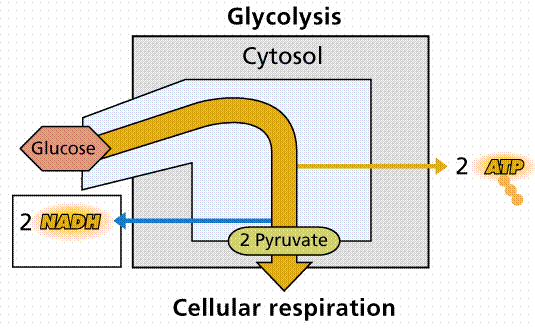
The pyruvate proceeds to being oxidised to a compound called acetyl coenzyme A upon reaction with coenzyme A which results in the production of yet another NADH and, voila! a carbon dioxide molecule, our first ever CO2; please welcome it graciously…
So far we’ve got 2 ATP, 3 NADH and 1 CO2 – not that impressive, onwards and upwards!
P.S.: the pyruvate –> acetyl-CoA step isn’t part of glycolysis, I just tagged it along to have 3 steps overall rather than 4. Magic numbers and all that.
Lipid and protein substrates for respiration
Instead of glucose – > pyruvate, there are lipid and protein sources of energy that cells tap into in the absence of glucose. Fatty acids get oxidised to acetyl sugars which are two-carbon compounds.
Amino acids get converted into glucose by a process called gluconeogenesis. Since amino acids have nitrogen atoms on top of the usual carbon, oxygen and hydrogen, those need to be removed first in a deamination reaction. This leaves a sugar-like ketoacid. Ever heard of the ketogenic diet? That’s the one.
Lipid and protein products like acetyl sugars and ketoacids enter the Krebs cycle as normal to carry out aerobic respiration, covered towards the end of this topic.
1.5. Anaerobic respiration
Let’s look at anaerobic respiration first, and continue with the muscle workout example. Under aerobic conditions, the NADH produced from glycolysis joins the Krebs cycle where the final electron acceptor following the electron transport chain is oxygen.
In anaerobic respiration there is no oxygen available, so what happens? Instead of getting oxidised by oxygen, NADH is oxidised by pyruvate. This being a redox reaction, pyruvate is at the same time reduced by NADH. This results in the formation of lactic acid which causes all the symptoms of strenuous exercise in the muscle.
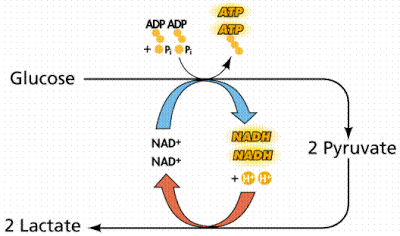
Lactate is the ion formed when lactic acid dissolves… For the purpose of talking about anaerobic respiration they’re equivalent!
The more lactic acid is formed as a result of increasing oxygen starvation, the larger the oxygen debt becomes. This is the amount of extra oxygen needed to make up for the lactic acid.
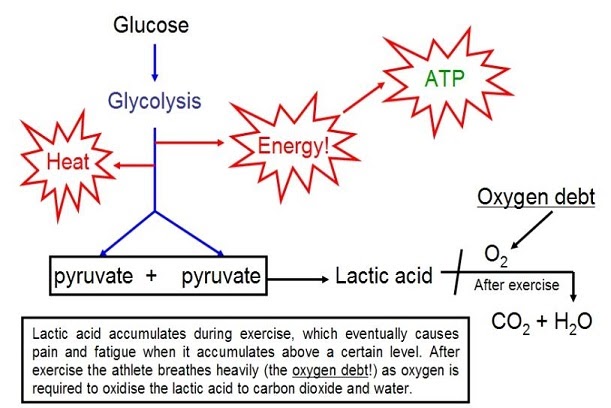
Yeast Fermentation and the Production of Ethanol
Another anaerobic respiration scenario occurs in yeasts. Instead of producing lactic acid from the reduced pyruvate, they produce ethanol. This is widely used as the alcohol in beer, wine, etc.

As seen in the diagram, post-glycolysis anaerobic and aerobic routes separate. So based on the notations, there are two options: anaerobic goes 1 -> 1.5 while aerobic goes 1 -> 2 -> 3.
2, 3. Aerobic respiration
There are 3 main stages of aerobic respiration:
1. Glycolysis that takes place in the cytoplasm (see above)
2. The citric acid (Krebs) cycle that takes place in the mitochondria
3. Oxidative phosphorylation that takes place in the mitochondria
2. The citric acid (Krebs) cycle
The previously produced acetyl-CoA gets oxidised to carbon dioxide, while NAD continues to be reduced to NADH. The CO2 gets eliminated when we exhale, while the NADH is passed onto the next and final step of aerobic respiration.
The Krebs cycle is a series of reduction-oxidation reactions (redox reactions) which produce multiple coenzymes. Coenzymes are molecules which assist enzyme in their catalysing activity.
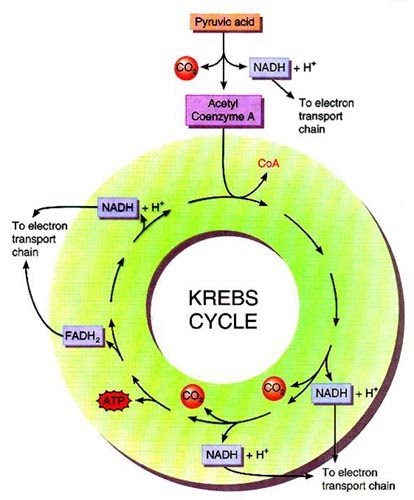
Acetyl-coA combines with oxaloacetate to form citrate (hence the cycle’s other name of the citric acid cycle), so the oxaloacetate is regenerated in the mitochondrial matrix. It is then followed by the above reactions. If there is no oxygen which will be required further down the line, the pyruvate goes down the anaerobic route and results in production of CO2 plus lactate or ethanol.
3. Oxidative phosphorylation
The NADH harvested from the Krebs cycle is oxidised back to NAD. This produces a stream of free electrons because, remember, oxidation = loss of protons or electrons. Dehydrogenase enzymes are the ones that catalyse the release of H ions and electrons. These electrons progress through the electron transport chain from coenzyme to coenzyme, down an energy gradient. Eventually they must be accepted by a terminal electron acceptor. This is oxygen, and that is why O2 is needed in aerobic respiration. The product is water, H2O.
The abundant ATP molecules are produced when the electron transport chain creates a proton gradient across the mitochondrial inner membrane (cristae). Since the gradient drives the force of protons being transferred across to the side where there are less of them, ATP is produced when the protons go through special cross-membrane enzymes which use the energy derived from their passage to turn one ADP molecule into one ATP molecule.
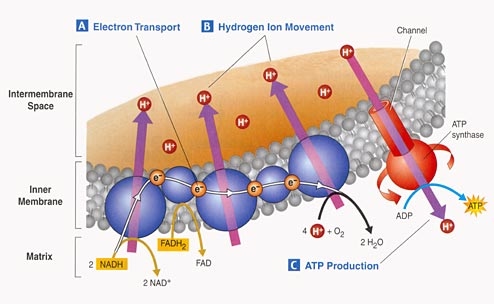
The respiratory quotient
Respiratory quotient (RQ) refers to the ratio between the amount of CO2 produced by an organism to the amount of O2 consumed.
It can be used to work out whether anaerobic respiration is occurring, and determine the respiratory substrate used e.g. carbohydrates, lipids or proteins. For example, a patient or athlete can be hooked up to a respirometer that records ventilation (breathing), oxygen concentration and carbon dioxide concentration in the air inhaled and exhaled, while using a treadmill.
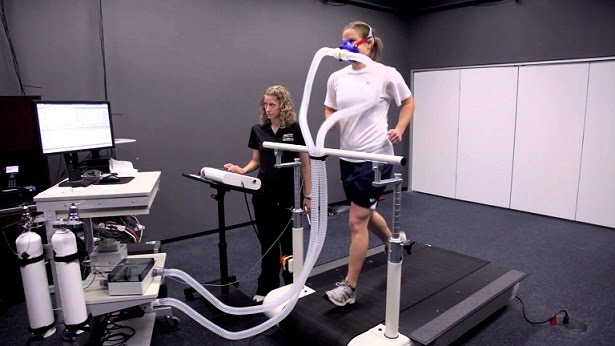
The data can be expressed as a ratio, and specific ratios are associated with different respiratory substrates. For example, a ratio of 1.0 denotes carbohydrate metabolism, 0.8 indicates protein while 0.7 suggests lipid breakdown.
RQ = CO2 eliminated / O2 consumed
The oxygen required in aerobic respiration can be linked to the substrate used. Glucose is more oxidised than fatty acids, so it requires less oxygen to be metabolised. This is why pure carbohydrate respiration gives a RQ of 1, while pure lipid respiration gives 0.7.
Several conditions can be diagnosed using the RQ of a patient, including underfeeding (RQ < 0.85), overfeeding (RQ > 1.0) and chronic obstructive pulmonary disease (COPD). COPD causes more respiratory effort to be made by the patient.
Ok byeeeee
